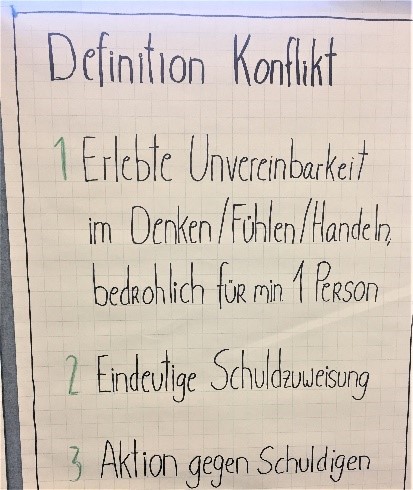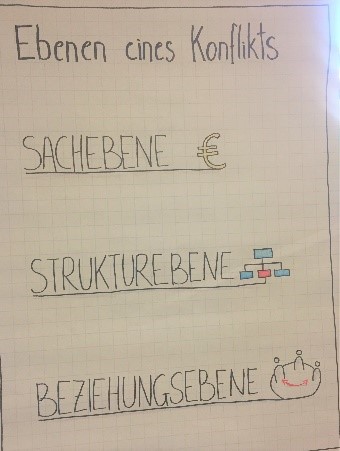Just because it's not noisy doesn't mean there's no conflict.
Christian Huppertz, Product Owner BMW
Conflict management in teams – especially in agile teams, is a challenge for every leader, every team member and can,
if not resolved – significantly impair the company’s success. This topic environment moved us at our last MeetUp and stimulated discussion among all participants.
Ellen Duwe, Agile Coach supported the practical examples of Christian Huppertz, Product Owner at BMW, with theory models.
From conflict emergence, to different stages of conflict, to resolution approaches and insights into the reality of agile teams, the two speakers took the attendees along for the ride.
The classical conflict theory states that three points are crucial for a conflict to prevail:

1. experienced inconsistency in thinking, feeling, acting that is threatening for at least one person.
2. a clear assignment of guilt must take place on which consequently an action (3.) takes place.
Also, in understanding conflict, it is important to understand the different levels.
Ellen Duwe about the different levels:
“Conflict of opinion can be beneficial – as long as it is purely about the matter at hand, e.g. a budget or work content. A discursive, even sometimes contradictory, exchange on factual issues in the team is necessary.
Without factual conflicts, there would be no progress, no innovation.
However, if factual conflicts become too heated, emotions come into play. A relationship conflict arises between two or more people.
The more intense the conflict, the stronger the emotional and the smaller the logically rational part in the discussion.
Conflicts of this kind tend to escalate and can lead to then best resolved through moderation or mediation by an uninvolved third party.
Structural conflicts are conflicts caused by the structure or processes of an organization. Unclear responsibilities, unequal budgets or non-transparent agreements are just a few examples.”

It helps to take a close look at all levels in a conflict, because especially in larger conflicts all three levels are involved.
In Scrum teams, for example, conflicts arise when new roles are assigned. This can happen when a new young Product
Owner joins a very experienced team and encounters resistance from the team because, for example, user stories are not written in the same way.
are as expected or the so-called “Ready Status” does not meet the expectations of the team. Christian Huppertz advises here the retrospective to
use to communicate to the TOE what the team expects and to identify conflicts early.
Because agile working does not avoid conflicts, but at best makes them visible at an early stage
In the case of major conflicts, Christian Huppertz reports from his experience that it is helpful to involve the Scrum masters of other teams or even
to ask the organization for help to clarify this. It should also be accepted that “professional conflicts are deliberate in order to
evolve the product and consider different points of view.”
Christian Huppertz on conflict examples:
“Another potential source of conflict has been the introduction of new working methods in which the roll and understanding of values changes, or even if new teams are found. Often, people with the most diverse experiences then meet
and backgrounds, each using the same terms, but with a different understanding and set of values behind them. Thereby there can be a lot of discussion or even argument when it comes to planning, budget allocation
or the distribution of tasks. Christian advises her, especially during the introduction, to make sure that people and teams understand the new roles, partly work them out themselves and together and also accept. Should this only lead to a
later on, it is helpful to address this clearly and openly either through a 1-to-1 clarification or in a team. In 1-to-1 clarification, the clarification should be communicated to the team with the solution so that the team can
is informed that the conflict has been resolved.”
When there is no way out of a conflictual situation, it is worthwhile to get an outside view. This can happen, for example, through external mediators, who can give new impulses through a neutral point of view, or can show ways in which the conflict parties can
find a solution. A prerequisite for outside assistance is that all parties agree to it.
If you are looking for a mediator, we recommend the experienced mediator Ellen Duwe from the Agile Sales Company
(https://www.agile-sales-company.de): ellen@agile-sales-company.de


